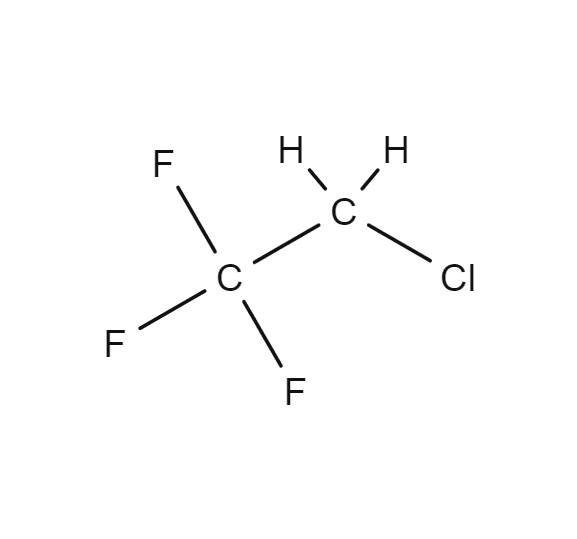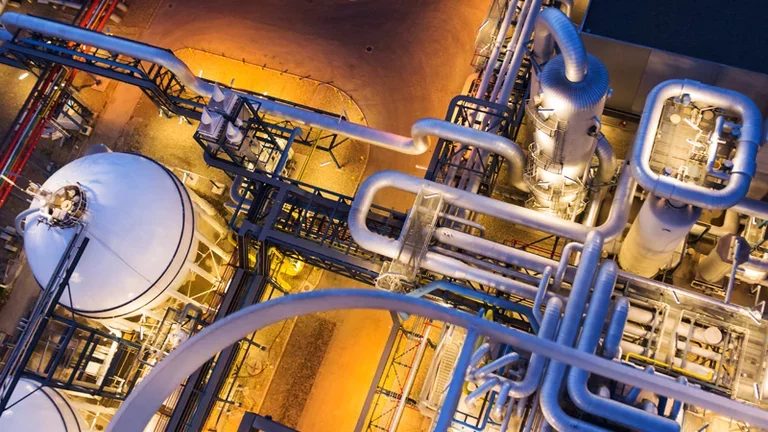
2-Chloro-1,1,1-trifluroethane
- C2H2ClF3
- CAS Number 75-88-7
- UN1928 (gas)
Click & drag to move the 3D molecule
Liquid / Gas Volumes
Calculate the volume or mass of a quantity of gas or liquid
Liquid Phase
At boiling point at 1.013 bar
Gas Phase
In standard conditions (1.013 bar, 15°C)
Physical Properties
Molecule phase diagram showing the transition phases between solid, liquid and gas as a function of temperature and pressure
-
- Molar mass 118.485 g/mol
- Content in dry air /
-
Critical Point
- Temperature 156.85 °C
- Pressure 38.4 bar
- Density 497.84 kg/m³
-
Triple Point
- Temperature -105.59 °C
- Pressure 4.013E-4 bar
Pressure 1.013 bar
| Latent heat of fusion (at melting point) | 61.949 kJ/kg |
| Melting point | - 105.59 °C |
Pressure 1.013 bar
| Boiling point | 6.1 °C |
| Latent heat of vaporization (at boiling point) | 200.028 kJ/kg |
| Liquid density (at boiling point) | 1373.06 kg/m3 |
Applications
Examples of uses of this molecule in Industry and Healthcare

Chemicals
2-Chloro-1,1,1-trifluroethane is an intermediate product in the production of chemicals. It is an anesthetic halothane.
Safety & Compatibility
GHS04
Gas under pressure
Metals
| Aluminium | Satisfactory |
| Brass | Satisfactory |
| Monel | No data |
| Copper | No data |
| Ferritic Steel | Satisfactory |
| Stainless steel | Satisfactory |
| Zinc | No data |
| Titanium | No data |
Plastics
| Polytetrafluoroethylene | Satisfactory |
| Polychlorotrifluoroethylene |
Significant swelling
Acceptable
|
| Polyvinylidene fluoride | Satisfactory |
| Polyvinyl chloride |
Significant swelling
Not recommended
|
| Ethylene tetrafluoroethylene | No data |
| Polycarbonate | No data |
| Polyamide | Satisfactory |
| Polypropylene |
Significant swelling
Not recommended
|
Elastomers
| Butyl (isobutene- isoprene) rubber | No data |
| Nitrile rubber | No data |
| Chloroprene | No data |
| Chlorofluorocarbons | No data |
| Silicone |
Significant swelling
Not recommended
|
| Perfluoroelastomers | Satisfactory |
| Fluoroelastomers | Satisfactory |
| Neoprene | No data |
| Polyurethane |
Significant swelling
Not recommended
|
| Ethylene-Propylene |
Significant swelling
Not recommended
|
Lubricants
| Hydrocarbon based lubricant |
Significant loss of mass
Not recommended
|
| Fluorocarbon based lubricant |
Significant loss of mass
Not recommended
|
Materials compatibility
Learn More
More information
Due to their ozone-depleting effect, the production of refrigerants is continuously decreasing, based on Montreal protocol requirements. Their use is controlled and they are progressively being replaced.